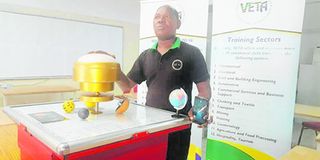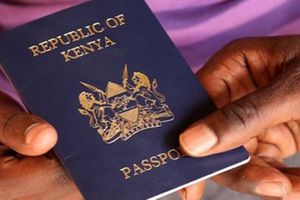Making teaching aid kit for outer space bodies

Ernest Maranya works on his teaching aid kit for outer space bodies. PHOTO | DEVOTHA JOHN
What you need to know:
Ernest Maranya, 33, is an upcoming innovator who has embarked on making a teaching aid kit for outer space bodies and atomic particles in his bid to enable science students get full knowledge about wonders of the world.
Innovation has inspired youth to realise their dreams, as the adage goes the sky is the limit, even when it comes to thinking of ideas.
Ernest Maranya, 33, is an upcoming innovator who has embarked on making a teaching aid kit for outer space bodies and atomic particles in his bid to enable science students get full knowledge about wonders of the world.
The equipment has been very handy in making geography and other science subjects an easy lesson. It is a solar system kit for use as teaching aid in the laboratory.
“This equipment will enable students to understand different issues like: rotation of the earth, solar system, axis, solar eclipse and tides,” says Maranya adding that it will enable students to relate theory and practice by merging their prior experiences with the texts and illustrations.
Maranya notes that students from primary school and secondary school from Form One to Six and the ones who pursue science subjects including geography, chemistry and physics are set to benefit from his innovation.
“In physics, students will be in a position to learn astronomical topics and gravitational force. In Geography, they will benefit from learning solar system while in chemistry they will learn atoms and their variegated functions,” says Maranya, adding that his kit has been tested and is 100 per cent efficient.
“The aim of this technology is to make students learn by doing. It will make teachers get away with mundane teaching style which embraced rote learning,” he says adding, further stating, “To get practical knowledge will enable students to investigate how the sun and planets affect mankind.”
He notes that due to this technology students will learn different issues, including Summer Season, moon eclipse, night-and-day, sources of planetary relations and planets and how they affect atmospheric tensions, stars and astronomy as a whole.
Mr Maranya has it that putting theory into practice enables students to retain permanent knowledge unlike in the past where teachers lacked enough tools to facilitate meaningful learning.
Maranya says he came up with this innovation after learning much about solar system and how magnetic field work in line with solar power.
History
Maranya, who is deaf, says he came up with the idea in 1997 when he was in Grade Six at Ukonga Primary School in Dar-es Salaam.
He says his quest to understand astronomy while at school; particularly solar system had immense value in his innovation.
“I had it in mind since when I was young that I would one day come up with an idea on how students can easily understand the earth and solar system,” says Maranya adding that he was always eager to know how planets affect each other, their relationships and why do they not fall on the earth.
He notes that while in primary school he had failed to bridge the gap between what he believed and what he was taught.
“I always wanted to know how planets affect each other, especially how the earth rotates around the sun without causing any harm to living organisms,” he recalls.
Maranya says he assumed that the planet is so heavy and too big, adding that when people said that there is a force and tension between the sun and the planet he could not imagine how possible was it that a variety of images were created without compromising the planets’ swimming in the sky.
Maranya notes after passing primary education with flying colours he was selected to join Benjamin Mkapa Secondary school in 2002, but unfortunately he did not pass for Advanced Secondary Education, he then opted for training in welding in 2004 at Vocational Training Authority (Veta).
“I had an opportunity to get scholarship at Veta after my innovation was televised live. I was demonstrating how a water pumping machine works,” said Maranya.
Veta in Dar es Salaam contacted me and showered good news that I had qualified for vocational training scholarship.
Maranya says he had undergone a course in welding apart from being able to improve his solar system innovation, thanks to Veta for recognizing his talent.
How the idea emerged
Maranya says in 2006 the country was facing power woes. He says there was incessant power rationing countrywide.
As a result he had to come up with the idea to innovate solar power in a bid to avert the problem.
He notes that he invented equipment which runs itself in the air and generates power.
He notes that this comes after examining how the solar system works and discovering the magnetic field of the solar energy which is able to fit the planet while in the sky and around.
“So I crafted my ideas, put them into words and gave them to the panel at the Ministry of Science and Technology,” he says, adding, “they found my idea very handy and encouraged me to put it into use,” but it wasn’t advanced further because the problem was solved.”
One of the panelists at the ministry advised him to think of another teaching kit, equipment that would be used as a teaching aid in Tanzanian schools.
After receiving the advice he started making a teaching aid kit for outer space bodies and atomic particles.
Maranya says he ordered some instruments, including magnets from China in 2010 and others were a donation by Veta so as to facilitate his mission.
He notes that, with some help from Veta he had been able to get accreditation in 2014, adding that this year he had already been evaluated by the Tanzania Institute of Education (TIE).
TIE had advised him to improve a few things in his innovation before embarking on seeking property rights.
“I’m now looking for support to reach my targets as I strive to improve the areas suggested by TIE,” he says.
Challenges
Maranya says he works day and night to make his project a success, adding that he sometimes misses free time to socialize.
He says Confederation of Science and Technology (COSTECH) is to blame for not empowering him to realise his dreams.
“Since 2013, I expected a lot from Costech in disseminating this technology to a wider range and in fact, to a good number of community members but unfortunately they have been paying lip service with little or no practical realities in place,” he says adding: “It was during President Jakaya Kikwete’s era when Prof Makame Mbarawa was minister of Science and Technology that upcoming innovators were encouraged to be certified and even got special recognition, but unfortunately the minister’s subordinates didn’t do much to help us further.”
He, however, thinks that in collaboration with Tanzania Institute of Education and Vocational Training Authority and since the Minister for Education knows what is at stake, things will work as planned in the foreseeable future.
However Maranya says he still needs money to finish his work, asking the Government and non-government organizations to help him to finish what he has established.
Way forward
Maranya is optimistic since the Minister for Education Science and Vocational Training, Prof Joyce Ndalichako has promised to work on his lofty ideas.
“The Minister has advised me to work closely with Veta and come up with something which will benefit a good number of Tanzanians. She actually knows and appreciates my innovation,” the joyous Maranya says.
He appeals to the Minister to continue helping him accomplish his task as he is nearly reaching his innovation targets.
Maranya also appeals to President John Magufuli to devise a viable mechanism of recognising upcoming innovators.
“I really wish I could be given ample time to have a talk with the President. I have quite a lot to share with him, especially matters pertaining to science and technology as Tanzania struggles to be an industrialized country by 2025,” says Maranya.




